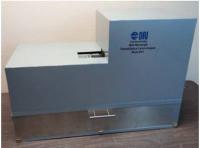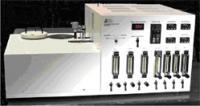2016 新产品:DRI2015 OCEC 多波段气胶碳成份分析仪

DRI Model 2015
Multi-Wavelength Thermal/Optical Carbon Analyzer
Magee Scientific, Production of DRI Model 2015
Overview
The DRI Model 2015 Multi-Wavelength Thermal/Optical Carbon Analyzer enhances the widely-used DRI Model 2001 system for quantifying organic carbon (OC), elemental carbon (EC, also termed Black Carbon [BC]), and temperature-separated carbon fractions on aerosol filter deposits. The Model 2015 retains OC and EC consistency with previous measurements while reducing costs of supplies and maintenance compared with the Model 2001. It replaces the 633 nm optical monitoring that accounts for OC charring with reflected (R) and transmitted (T) intensities at wavelengths of 405, 445, 532, 635, 780, 808, and 980 nm. The additional optical information can be used to estimate multi-wavelength light absorption of the sampled particles, quantify the concentration of brown carbon (BrC) in each sample, and further complement the use of carbon fractions in source apportionment studies.
Model 2015 software includes temperature programs for commonly-used protocols such as IMPROVE_A, EUSAAR, and NIOSH, and it can be programmed to emulate any other protocol. The simultaneous measurement of both R and T at all wavelengths throughout each analysis allows for reproducing any other thermal/optical method and holds potential for better characterizing additional properties of the carbonaceous aerosol.
有机碳/元素碳分析仪 (DRI-2001A OC/EC Analyzer)_已经停产
The Model 2001 is the much refined, commercialized version of the OC/EC analyzer used at Desert Research Institute for the U.S. EPA’s visibility assessment program “Interagency Monitoring of Protected Visual Environments (IMPROVE)”. It was developed with key features to facilitate particulate carbon research as well as analytical production. Some of the features like dual modes of pyrolysis monitoring, automatic boat inlet, and MS ACCESS, do increase the cost of the analyzer. But the resulting product is unmatched by other analyzers. An automatic sample loader, due to be released in late 2007 will work in conjunction with the automatic boat inlet to process up to 18 samples sequentially unattended. The analyzer designated as Model 2001A can be fitted with the automated sample loader at any time subsequent to the initial purchase.
有机碳/元素碳分析仪 (Thermal Optical Carbon Analyzer, DRI Model 2001A)是以电脑操控分析气胶成份仪器,应用於分析收集在滤纸上微粒样品中的有机碳和元素碳(OC/EC)含量。 原理: 气胶样品中的有机碳和元素碳含量由IMPROVE(Interagency Monitoring of Protected Visual Environment)分析协议规定的加热光学反射法(TOR)获得。该方法的主要测试原理是:在无氧的纯氦气环境中逐步(温度梯度)加热,将 0.530 cm2的滤纸上的微粒态碳转化为 二氧化碳(CO2);然后再将样品在含2%氧气的氦气环境下逐步(温度梯度)加热,此时样品中的元素碳释放出来。上述各个温度梯度下产生的CO2,经氧化炉(MnO2)催化,於还原环境下转化为可通过火焰离子化检测器(FID)检测的甲烷(CH4) 。 样品在加热过程中, 部分有机碳可发生裂解现象而形成黑碳,使滤膜变黑,导致图谱上的有机碳和元素碳峰不易区分。因此,在测量过程中,采用 633 nm的氦-氖激光监测滤纸的反射光强度变化,明确指示出元素碳氧化的起始点。有机碳裂解过程中形成的碳化物称之为裂解碳(OPC)。因此,当一个 样品完成测试时,同时获得有机碳和元素碳的8个组分(OC1、OC2、OC3、OC4、EC1、EC2、EC3、OPC),IMPROVE协议将有机碳定义为 (OC1+OC2+OC3+OC4+OPC), 将EC定义为 (EC1+EC2+EC3-OPC)。
应用: 目前该仪器负责美国最大的大气微粒研究计画-IMPROVE OC/EC样品的分析,已分析超过10万张滤纸,并在美国的100多个微粒研究计画中得到应用。 该仪器还可以使用 NIOSH (National Institute of Occupational Safety and Health)方法测定样品中的OC/EC含量。由於NOISH(Method 5040,SUNSET公司碳分析仪使用的测试方法)设计时是针对污染源样品(如柴油车尾气)的采集,未考虑环境大气的实际情况, 如环境大气中矿物含量较高时,其所测的EC含量偏低,比TOR/TOT方法测试的EC值偏低达2倍。尽管NIOSH是美国唯一的由国家级研究机构颁布的柴油微粒的测定方法,但由於环境测量的不准确性,美国环境保护署(USEPA)已经决议采用IMPROVE方法代替NIOSH进行OC/EC测量,并在即将开进行的区域大气灰霾(长达65年)观测中采用IMPROVE方法。商业化的微粒碳成分监测仪,虽能提供OC/EC的实时测量,但样品在采样现场已用完,无法进行QAQC。此外,部分采用元素分析仪以两步燃烧法(450oC/950oC)测量的OC/EC,由於OC测量过程中产生的聚合碳未进行含量校正,导致OC与EC的分离点不准确,影响测量结果的准确性。
侦测极限与范围 Typical lower MDL (minimum determine limits, ideal conditions) - OC: 0.82 μg C /cm2 ; EC: 0.20 μg C /cm2 ; TC(Total Carbon): 0.93 μg C /cm2 测量范围: 0.2-750μg C /cm2


